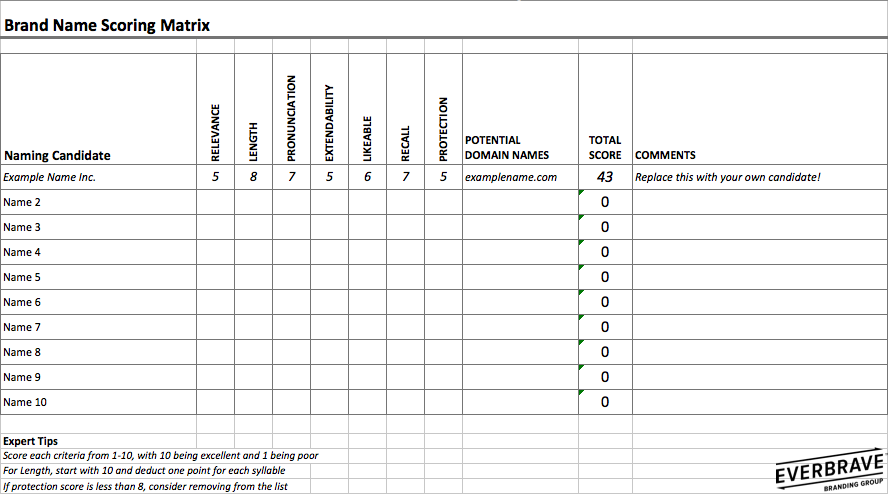Seven Key Things to Consider When Naming a Company
The genesis of any brand always starts with a great idea for a product or service that you believe is a viable business concept or add-on to your existing brand. Smart, well-intentioned people gather together and hash out the details of what this killer new business is going to do, how it will be better than the competitors, and then usually (hopefully) determine its viability from a financial standpoint. And then you’re faced with this critical question: what do we call it?
So you start scratching out ideas for the company name on the back of napkins or in your business idea notes. You start obsessing over it, thinking about it while you’re driving, eating, jogging, even sleeping. Ideas start to percolate, and you start building a list of name candidates. You pick a favourite and then ‘Google it’, only find out that the name is being used by another company, sometimes in the exact same business. Maybe you repeat this process a few times and end up frustrated, or maybe you strike gold and land on something truly unique! But how do you know if the name your considering is any good?
There are plenty of psychoanalytical reasons as to what your audience values in a name, but I’m no psychologist, so I won’t even think about going there. What I can help with is providing a list of sensible criteria that you can use to measure the ideas you do have, and narrow it down to the best possible candidate(s).
NAMING STRUCTURE
Before you go too deep into this process, it’s important to make sure your naming concepts are structured properly and have all of the ingredients of a proper trade name (at least in North America). Your name should have the following elements at a minimum:
- Unique Identifier – This can be anything and will usually be the default name of the company. In our case, ‘Everbrave’.
- Descriptor – Sometimes referred to as the strapline, this descriptor says what unique service you provide. When combined with the Identifier, you should have a unique combination that only your company has in your particular trade market, and business category. In our case, it’s ‘Branding Group’.
- Legal Identifier – Once you have gone through the process of registering a corporation, you will need to append the designation you’ve chosen. Either Ltd., Inc., LLP., LLC etc. It varies in different jurisdictions, so you’ll need to consult with your lawyer or local registry. In our case, we had a choice, so we chose Ltd. and as such, our full legal trade name is Everbrave Branding Group Ltd.
The first two items above are particularly important when vetting your names through the qualification process described below.
NAMING CRITERIA
To avoid frustration, we suggest having multiple options and not getting too obsessed with one particular selection. It can be a frustrating process to build an entire business plan around one specific name, only to find out it unusable, so keep your search wide and keep an open mind.
Once you have your list of candidates (we usually aim for eight to ten to start with), we like to ensure that they have high potential. Here are seven things to get right when evaluating your new naming candidates:
- Relevance – This is pretty simple really, if you get the descriptor right, the relevance should follow. However, you should get some bonus marks if your identifier is also relevant. Basically, just don’t be irrelevant for the sake of creativity and count on your audience to figure it out on their own. Some might argue that a name like Lululemon lacks relevance, but when you add their descriptor (Athletica) it qualifies the name as relevant.
- Length – Our suggestion is to aim between one and three syllables for the identifier part of your name. It’s not to say that longer words aren’t good, they should just score a little lower compared to shorter options (more on scoring below).
- Pronunciation – It’s important to ensure that you’re not laying down a tongue twister for your audience. Consumers can get uncomfortable struggling to figure out how to pronounce a name, especially if they’re telling their friends about. It should ideally make sense (phonetically) in the primary language your audience speaks. You can measure this by testing the name with colleagues and friends or family by simply showing it to them and asking them to say it out loud. Watch their reaction and listen carefully to ensure they react and pronounce it the way you intended.
- Extendibility – Many brands grow over time by adding new channels, products, divisions, or even sub-brands. Measure whether your name has the potential for growth as a part of a larger system. Go completely blue-sky with the possibilities of where the company can go in the future.
- Likeable – Even though you may personally fall in love with a particular name because of some deep rationale or reasoning, it doesn’t mean your audience will like it. Do some basic qualitative research with friends and family or colleagues to determine if they like the way it sounds and feels, or even looks when spelled out. Sometimes it’s easier to ask a third party to do this polling on your behalf so you get a more honest and unfiltered view and opinion.
- Recall – Using the same sample group as you have been so far for testing and research, go back to them seven days later and ask them to remember all of the names you showed them. Determine which ones spring up first more often and give those names bonus marks. If you have a difficult to remember brand name, the hill of brand awareness just got a little steeper.
- Protection – Ultimately, if you can’t formally protect a trade name through the trademark process, you might want to reconsider. Sometimes a name can be protected in one jurisdiction, but not in another. For example, the name you want may be protected in the USA but not well known or registered in Canada, and you may feel it’s worth the risk. In an ideal scenario, you’ll have a relatively clear path to protection in the place(s) you plan on doing business now and in the future. There are a few resources you need to check.
A) Canadian Intellectual Property Office (CIPO) – You can search for your Identifier here to see what other companies may already hold a formal trademark on your name.
B) US Patent Office – Same process as the Canadian system if you plan on doing business in the United States.
C) Rebel.ca – This is a handy domain name search tool. Make sure that there is a suitable domain name available for your business name. You might need to get creative with your domain name options as the field of plain English word combinations is getting pretty thin!
D) Google – Do some basic research here to find out what kind of other businesses are using your desired name in any form to make sure you won’t be creating confusion in the market place.
This is just scratching the surface or protectability. It’s often easier to consult with a qualified trademark attorney to vet your top list of candidates, these tips will hopefully help you shorten your list a little bit. Many jurisdictions have other qualifying requirements not listed here that should be considered if not going the trademark route.
MEASURING YOUR SELECTIONS
It’s often easiest to narrow your list of candidates using a scoring criteria, rather than pure subjective preference. You would be surprised sometimes at the names that rise to the top of list once you’ve gone through this! Here is the matrix and scoring system we recommend in your evaluation process.


This should provide you with a solid rationale for one to three names (your top candidates) that you can choose from when discussing with your attorney.
Great names are just the start of the branding process, but it’s a choice you’ll live with long term. How the company evolves will determine if you’re on the path to legendary status!


